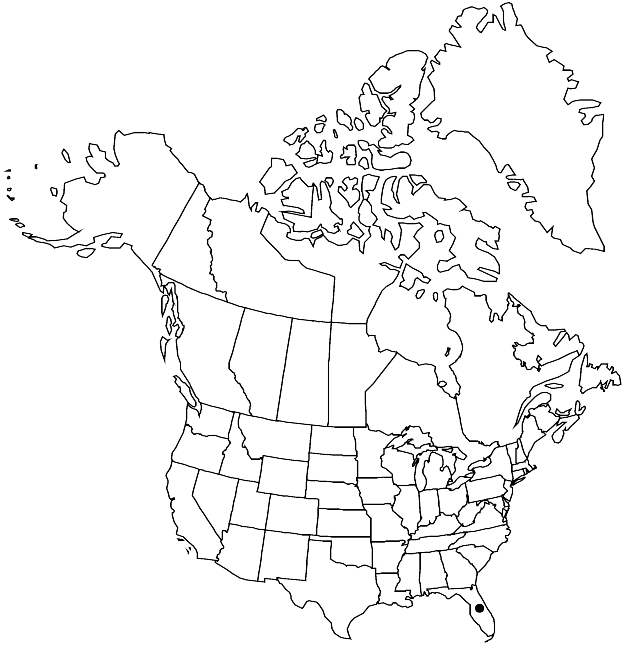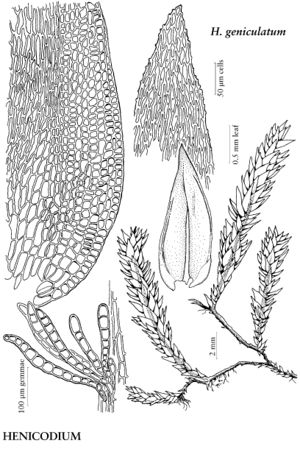Difference between revisions of "Henicodium geniculatum"
Bryologist 92: 534. 1989.
FNA>Volume Importer |
imported>Volume Importer |
||
| (6 intermediate revisions by 2 users not shown) | |||
| Line 9: | Line 9: | ||
|special_status={{Treatment/ID/Special_status | |special_status={{Treatment/ID/Special_status | ||
|code=F | |code=F | ||
| − | |label= | + | |label=Illustrated |
}} | }} | ||
| − | |basionyms={{Treatment/ID/ | + | |basionyms={{Treatment/ID/Basionym |
|name=Leucodon geniculatus | |name=Leucodon geniculatus | ||
|authority=Mitten | |authority=Mitten | ||
| + | |rank=species | ||
| + | |publication_title=J. Linn. Soc., Bot. | ||
| + | |publication_place=12: 409. 1869 | ||
}} | }} | ||
|synonyms={{Treatment/ID/Synonym | |synonyms={{Treatment/ID/Synonym | ||
|name=Leucodontopsis floridana | |name=Leucodontopsis floridana | ||
|authority=(Austin) E. Britton | |authority=(Austin) E. Britton | ||
| − | }}{{Treatment/ID/Synonym | + | |rank=species |
| + | }} {{Treatment/ID/Synonym | ||
|name=L. geniculata | |name=L. geniculata | ||
|authority=(Mitten) H. A. Crum & Steere | |authority=(Mitten) H. A. Crum & Steere | ||
| + | |rank=species | ||
}} | }} | ||
|hierarchy=Pterobryaceae;Henicodium;Henicodium geniculatum | |hierarchy=Pterobryaceae;Henicodium;Henicodium geniculatum | ||
| Line 35: | Line 40: | ||
|elevation=low elevations (0 m) | |elevation=low elevations (0 m) | ||
|distribution=Fla.;Mexico;West Indies;Central America;South America;se Asia;Africa. | |distribution=Fla.;Mexico;West Indies;Central America;South America;se Asia;Africa. | ||
| − | |discussion=<p>Henicodium geniculatum has mostly simple, erect secondary stems, and leaves with single costae. The margins are recurved throughout, and the laminal cells are 1-papillose. The species may be distinguished from Pireella by its leaves that are appressed when dry and spreading when moist (rather than little altered when dry), and laminal cells papillose over the lumina (rather than smooth or prorulose). Henicodium seems most often confused with poorly developed specimens of Pseudocryphaea domingensis; that species has a percurrent costa, laminal cells much wider and usually smooth, and no axillary gemmae but, usually, conspicuous flagellate branches.</p> | + | |discussion=<p><i>Henicodium geniculatum</i> has mostly simple, erect secondary stems, and leaves with single costae. The margins are recurved throughout, and the laminal cells are 1-papillose. The species may be distinguished from <i>Pireella</i> by its leaves that are appressed when dry and spreading when moist (rather than little altered when dry), and laminal cells papillose over the lumina (rather than smooth or prorulose). <i>Henicodium</i> seems most often confused with poorly developed specimens of <i>Pseudocryphaea domingensis</i>; that species has a percurrent costa, laminal cells much wider and usually smooth, and no axillary gemmae but, usually, conspicuous flagellate branches.</p> |
|tables= | |tables= | ||
|references= | |references= | ||
| Line 44: | Line 49: | ||
-->{{#Taxon: | -->{{#Taxon: | ||
name=Henicodium geniculatum | name=Henicodium geniculatum | ||
| − | |||
|authority=(Mitten) W. R. Buck | |authority=(Mitten) W. R. Buck | ||
|rank=species | |rank=species | ||
| Line 57: | Line 61: | ||
|publication title=Bryologist | |publication title=Bryologist | ||
|publication year=1989 | |publication year=1989 | ||
| − | |special status= | + | |special status=Illustrated |
| − | |source xml=https:// | + | |source xml=https://bitbucket.org/aafc-mbb/fna-data-curation/src/2e0870ddd59836b60bcf96646a41e87ea5a5943a/coarse_grained_fna_xml/V28/V28_943.xml |
|genus=Henicodium | |genus=Henicodium | ||
|species=Henicodium geniculatum | |species=Henicodium geniculatum | ||
Latest revision as of 22:39, 5 November 2020
Stems erect, from stolons turning away from substrate. Stem leaves 1.2–2 × 0.2–0.9 mm; apex gradually, broadly acuminate, often appearing abruptly so because of subapical recurved margins; costa often obscured by plicae, especially distally; alar cells in 7–15 rows, extending along margins by 25–50 cells, collenchymatous; medial laminal cells 42–71 × 4 µm. Sporophytes unknown.
Habitat: More or less open, mesic to dry forests, branches, tree trunks, canopy
Elevation: low elevations (0 m)
Distribution

Fla., Mexico, West Indies, Central America, South America, se Asia, Africa.
Discussion
Henicodium geniculatum has mostly simple, erect secondary stems, and leaves with single costae. The margins are recurved throughout, and the laminal cells are 1-papillose. The species may be distinguished from Pireella by its leaves that are appressed when dry and spreading when moist (rather than little altered when dry), and laminal cells papillose over the lumina (rather than smooth or prorulose). Henicodium seems most often confused with poorly developed specimens of Pseudocryphaea domingensis; that species has a percurrent costa, laminal cells much wider and usually smooth, and no axillary gemmae but, usually, conspicuous flagellate branches.
Selected References
None.
